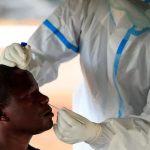 Gauteng is the smallest of South Africa’s nine provinces but home to a quarter of the country’s population. It is also the country’s economic power house. These factors have contributed to it becoming the epicentre of the COVID-19 epidemic.
Gauteng is the smallest of South Africa’s nine provinces but home to a quarter of the country’s population. It is also the country’s economic power house. These factors have contributed to it becoming the epicentre of the COVID-19 epidemic.
Gauteng’s COVID-19 surveillance aims to provide an understanding of the province’s experience. This also serves as an early warning system for other parts of the country. Public health medicine specialist Harsha Somaroo is part of the team analysing data for the Gauteng Department of Health and told The Conversation Africa what it’s showing so far.
What’s your data showing about COVID-19 in Gauteng?
In the four epidemiological weeks (13 November to 4 December, 2021), there was an exponential rise in new COVID-19 cases. The province officially entered its fourth COVID-19 wave on 1 December.
During this period South African scientists announced they had identified a new variant of SARS-CoV-2, which the World Health Organisation went on label a variant of concern and named it Omicron. Current data show that the Omicron variant is dominating new COVID-19 cases in the province.
The rate of increase in new cases in Gauteng has been significantly higher compared to any other period in the epidemic in the province. The weekly rates of increase in new infections, when compared to the previous week, were 71%, 341%, 379% and 272%.
The COVID-19 test positivity rate (the number of tests done that have a positive result) for the past four weeks, were 1.4%, 5.0%, 19.0%, and 33.9%. This reveals a rapid rise, and now widespread community transmission, of SARS-CoV-2 in Gauteng.
What does your data tell us about Omicron?
The recent exponential rise in new COVID-19 cases, associated with the detection and domination of the Omicron variant in the province, suggests that this SARS-CoV-2 variant of concern is highly transmissible.
It is also possible to understand the severity of illness better by monitoring trends and outcomes among hospitalised patients. There are two sets of data that provide insights – hospitalisations and excess deaths. Excess deaths are deaths above the number expected in a region for that point in time, and give an indication of the COVID-19 related deaths in a region.
Compared with previous periods during which the numbers have spiked the latest numbers show that new daily COVID-19 hospitalisations and excess deaths have been lower than the rate of increase in new COVID-19 cases, suggesting that the variant may cause less severe illness.
Continued next page
(258 VIEWS)


Pingback: New coronavirus cases in Zimbabwe up again | The Insider